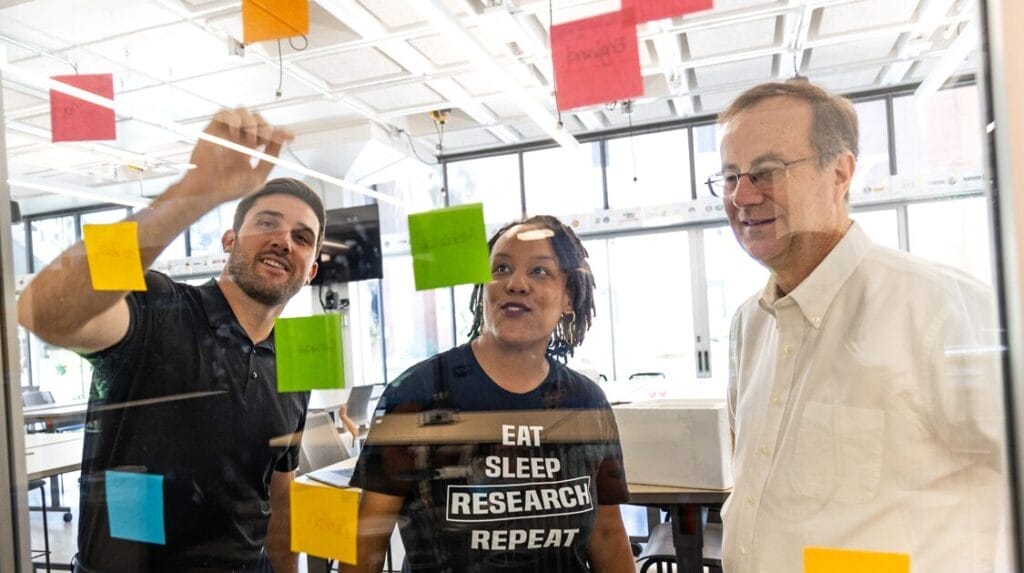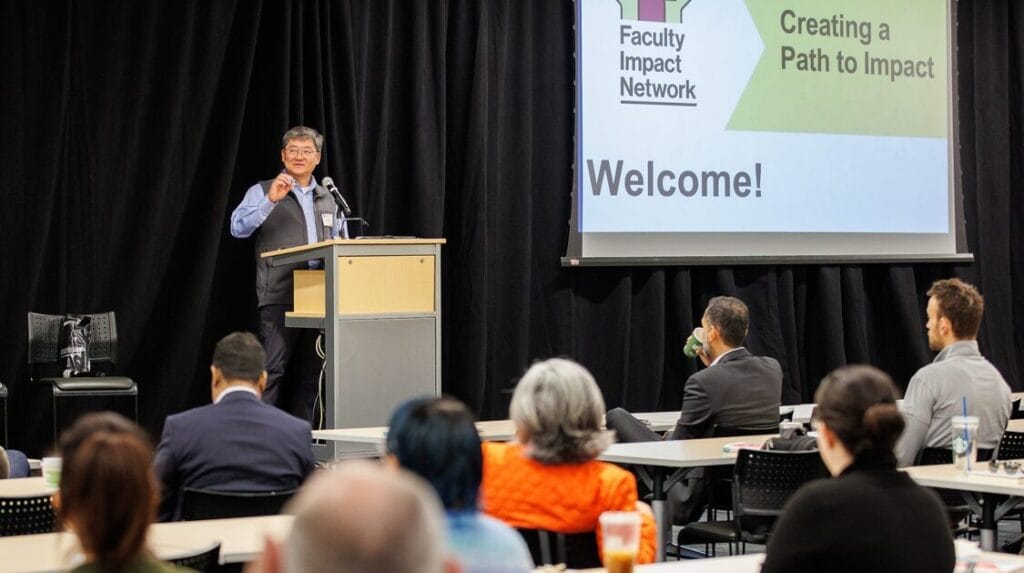
At Arizona State University (ASU), we are changing the way the world solves problems. From rising global temperatures to opioid addiction, emerging diseases to disinformation, the biggest challenges we face are complex, interdependent, and daunting.
But in academia, groundbreaking discoveries and innovative research often remain confined within the walls of universities and laboratories. Even so these ideas have the potential to transform industries, solve real-world problems and contribute to economic growth.
That is why, as the number one university for innovation, ASU seeks to fundamentally change the way the world solves problems. By fostering a culture of entrepreneurship, ASU empowers its faculty and researchers to bring their innovations to life and make a real-world impact. For faculty and researchers at ASU, the process of commercializing academic research is supported by a wealth of resources, programs and partnerships tailored to their needs.
This guide will walk you through the essential steps to commercialize academic research at ASU, offering practical advice and resources to help you navigate this exciting journey.
1. Understand the Value of Your Research
The first step in commercialization is recognizing the potential of your research. Not all academic work is suitable for commercialization, so it’s essential to evaluate whether your findings address a specific problem, fulfill a market need or offer a competitive advantage. Start by asking these key questions:
- What problem does your research solve?
- Who will benefit from your solution?
- How does it compare to existing solutions?
At ASU, the Faculty Entrepreneurship team and resources like Venture Devils can help you assess and refine your ideas for market readiness. While Venture Devils supports students at all levels, the Faculty Entrepreneurship team provides tailored guidance for faculty-led ventures. This dual approach ensures that researchers and students have the resources to succeed.
In addition to identifying the value of your research, leveraging feedback from potential stakeholders early in the process can clarify your work’s practical applications and market potential. Faculty and students are encouraged to collaborate with industry experts and use ASU’s networks to gain valuable insights.

Photo of Dr. Nina Sharp of DeSmart Lab
Dr. Nina Sharp, founder and director of the DeSmart Lab, exemplifies how ASU’s ecosystem empowers innovation. “My entrepreneurial journey began with a personal challenge—managing migraines—which motivated me to develop an LED specifically designed for individuals who share this experience,” says Dr. Sharp. “In collaboration with Dr. Todd Schwedt at Mayo Clinic Arizona, we brought together a multidisciplinary team to address this pressing health issue with an innovative solution. Receiving the Flinn Foundation grant is a testament to the impact of this work and will help accelerate the process of scaling the product to reach those who need it most. I am also deeply appreciative of the support provided by ASU’s E+I Institute, which plays an important role in guiding the growth of our venture.”
2. Protect Your Intellectual Property (IP)
Before sharing your research with others, secure your intellectual property. Skysong Innovations, ASU’s technology transfer arm, is a vital resource for protecting and managing your IP. Common methods include:
- Patents: Protect inventions or processes.
- Copyrights: Secure written materials, software or artistic works.
- Trademarks: Safeguard brand names or logos associated with your product.
Skysong Innovations simplifies the IP protection process and offers support for researchers navigating the complexities of intellectual property law. Once your innovation is protected, they can also assist with licensing agreements and technology transfer, ensuring that your work reaches the marketplace efficiently. Learn more about their services on the Skysong website.
Additionally, filing an invention disclosure early is critical for ensuring that your intellectual property is safeguarded throughout the commercialization process. The team at Skysong Innovations can guide you through each step, from disclosure to market launch.

3. Leverage Key Programs and Resources
ASU and its partners offer various programs to support commercialization efforts:
NSF Engines: Southwest Sustainability Innovation Engine (SWSIE)
The SWSIE provides non-dilutive grants ranging from $100,000 to $250,000 for sustainability-focused projects in the energy, water and carbon sectors. These grants are designed to help researchers achieve significant technical and commercial milestones.
NSF I-Corps Hub: Desert and Pacific Region
Part of a vibrant partnership across nine universities in five states — Arizona, California, Hawai’i, Idaho, and Nevada — this hub empowers innovation through regional training, mentorship and funding opportunities. High-performing teams may qualify for the National I-Corps Teams program and $50,000 grants to advance their ventures. Learn more and apply at NSF I-Corps Desert and Pacific Region.
This program also emphasizes customer discovery and hypothesis testing, helping teams validate their ideas and strengthen their commercialization strategies. Faculty and researchers can leverage this training to maximize the impact of their innovations.
J. Orin Edson Entrepreneurship + Innovation Institute
The institute supports entrepreneurs at all stages. For faculty-led ventures, the Faculty Entrepreneurship team offers tailored support, including access to training, funding opportunities and maker spaces. For students, programs like Venture Devils provide mentorship, networking, and resources to develop their ventures. Explore more on the Edson E + I website.
Office for Research and Sponsored Projects Administration (ORSPA)
ORSPA plays a critical role in supporting faculty throughout the research lifecycle, from proposal preparation to project closeout. Resources include:
- Pre-Award Services: Assistance with identifying funding opportunities, building budgets and ensuring compliance with funding requirements
- Post-Award Services: Guidance on financial accountability, cost-sharing and ensuring proper use of funds
- Additional Resources: Training on audit readiness, managing international collaborations and more
Visit ASU Research Administration for a complete overview of ORSPA’s services and tools.
4. Develop a Commercialization Strategy
Once you’ve identified the market potential, now you can outline your commercialization strategy. Consider these pathways:
- Licensing: License your IP to an existing company for development and marketing.
- Startups: Launch a startup to bring your innovation to market.
- Collaborations: Partner with established companies to co-develop solutions.
The Faculty Entrepreneurship team, alongside Skysong Innovations, can guide you in choosing the best pathway for your research. For example, ASU spinout companies have raised more than $700 million in external funding to date, thanks to these strategic approaches.
A strong commercialization strategy also involves defining clear milestones. Whether it’s achieving technical proof of concept, securing a partnership, or attracting early funding, each step brings your innovation closer to market readiness.
5. Secure Funding
Funding is crucial for advancing research into market-ready solutions. In addition to the NSF programs, ASU offers:
- Seed Grants: University-specific funding for early-stage research
- SBIR/STTR Programs: Federal grants for small business innovation and technology transfer
- Lab to Launch Awards: Funding to support SBIR/STTR applications and other commercialization activities
High-impact ventures may also benefit from partnerships with organizations like InvestU, which connects startups with investors for further development. Collaborations with the Arizona Commerce Authority and access to the SBIR/STTR Fast Grant program provide additional avenues for financial support.
Sonia Vohnout, CEO of OppsSpot, LLC and an experienced SBIR/STTR consultant, highlights the transformative potential of these programs. “The SBIR/STTR program fuels innovation with non-dilutive funding and fosters partnerships with research institutions, enabling small businesses to transform ideas into market-ready solutions,” she said. “As CEO of OppsSpot, I guide businesses through the program, assist in crafting winning proposals, and develop strategies for long-term success. With decades of experience, I deliver tailored guidance, training and insights to maximize funding opportunities and drive impactful growth.”

6. Participate in Key Events
Engage with the startup ecosystem by attending events like Lab to Launch. The next Lab to Launch event is scheduled for March 7, 2025, at Skysong. This event brings together founders, mentors, investors and faculty to prepare ventures for funding opportunities. Highlights include expert pitch development, SBIR/STTR assistance and networking opportunities. Previous events have included participation from corporate partners, investors and entrepreneurship leaders, creating invaluable connections for attendees.
Networking opportunities at Lab to Launch and similar events are designed to foster collaborations that drive success. Whether it’s finding mentors or engaging with investors, these events are pivotal in turning academic research into viable ventures.
7. Build a Strong Team
Successful commercialization often requires a multidisciplinary team. Consider recruiting individuals with expertise in:
- Business development: To craft strategies and identify opportunities.
- Product development: To turn your research into a market-ready solution.
- Marketing and sales: To connect with customers and generate revenue.
ASU’s incubator programs and entrepreneurship networks can help faculty build and connect with skilled teams, ensuring their ventures have the expertise needed to thrive. For researchers unfamiliar with startup operations, ASU’s mentors and workshops can provide foundational knowledge to build confidence and capability.
Move From Discovery to Impact
Commercializing academic research is a transformative journey that bridges the gap between discovery and impact. By leveraging ASU’s extensive resources, including the Faculty Entrepreneurship team, Skysong Innovations, NSF I-Corps programs, the J. Orin Edson Entrepreneurship + Innovation Institute, and ORSPA, researchers can bring their innovations to life and make a meaningful difference. Whether you choose to license your IP, launch a startup or collaborate with industry partners, ASU is here to support every step of your journey.
For additional guidance, contact the Faculty Entrepreneurship team:
- Tracy Lea, Director of ASU Innovation2Market: [email protected]
- Justin Mitchell, Senior Program Manager: [email protected]
Visit ASU Research Administration for further resources and opportunities.


